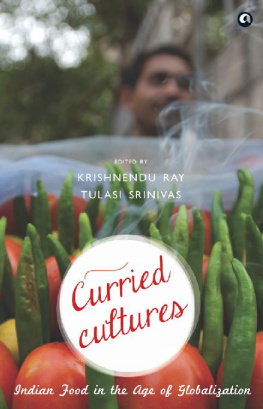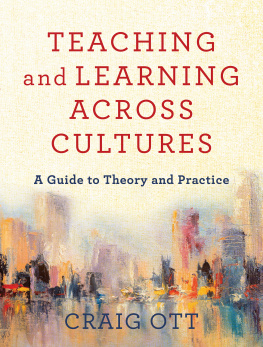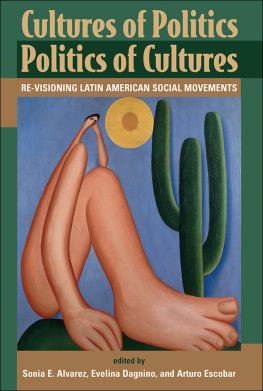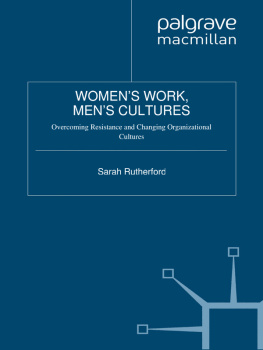Curried Cultures
ALEPH BOOK COMPANY
An independent publishing firm
promoted by Rupa Publications India
Published in India in 2017
by Aleph Book Company
7/16 Ansari Road, Daryaganj
New Delhi 110 002
The South Asian edition of this book is made possible by permission of the The Regents of the University of California 2017, and may be sold only in South Asia.
All rights reserved.
The views and opinions expressed in this book are the authors own and the facts are as reported by them, which have been verified to the extent possible, and the publishers are not in any way liable for the same.
No part of this publication may be reproduced, transmitted, or stored in a retrieval system, in any form or by any means, without permission in writing from Aleph Book Company.
ISBN: 978-93-84067-32-8
1 3 5 7 9 10 8 6 4 2
For sale in the Indian subcontinent only
This book is sold subject to the condition that it shall not, by way of trade or otherwise, be lent, resold, hired out, or otherwise circulated without the publishers prior consent in any form of binding or cover other than that in which it is published.
To my mother Rukka Srinivas for stirring in me a fascination for all things gastronomic.
To Rudra and Babul for keeping me sane.
To Sierra Burnett Clark and Jackie Rohel for all the unacknowledged work.
CONTENTS
PART ONE
OPENING THE ISSUES
Krishnendu Ray and Tulasi Srinivas
Akhil Gupta
PART TWO
THE PRINCELY-COLONIAL ENCOUNTER AND THE NATIONALIST RESPONSE
Angma D. Jhala
Jayanta Sengupta
PART THREE
CITIES, MIDDLE CLASSES, AND PUBLIC CULTURES OF EATING
Stig Toft Madsen and Geoffrey Gardella
Holly Shaffer
Susan Dewey
Elizabeth Buettner
Krishnendu Ray
Arijit Sen
Tulasi Srinivas
R. S. Khare
PART ONE
Opening the Issues
ONE
Introduction
Krishnendu Ray and Tulasi Srinivas
SOUTH ASIA IS A NEW HUB of intersecting global networks nourished by proliferating material and symbolic transactions propelling bodies, things, and conceptions across national boundaries. In this book, traversing national boundaries is the contingent operational definition of globalization. That implies at least two things: globalization becomes more visible after national boundaries crystallize; and we witness a new kind of self-consciousness about the connections between various locales and between the local and the supralocal in this phase of globalization. Furthermore, the affiliation of food to the body makes comestibles intensely local, in spite of their long history of distant circulation. Thus food is a particularly productive site to interrogate a new iteration of something old, because it links not only the global to the local, but the mind to the body and beyond. By weaving densely local stories, this book draws attention to processes of globalization as they play out at particular places and on specific peoples conceptions of themselves and their world.
In the last quarter of the twentieth century, new nodes in the global traffic in capital and culture joined previous flows of the capitalist world-economy from the edges of the Mediterranean and the Atlantic. Works such as The Globalization of Chinese Food (Wu & Cheung 2004), Asian Food: The Global and the Local (Cwiertka & Walraven 2001), The Globalization of Food (Inglis & Gimlin 2009) and Globalization, Food and Social Identities in the Asia Pacific Region (Farrer 2010) bear witness to those transformations. Until now there has been no comparable work centering on the South Asian wellspring of unconventional flows of bodies, edible commodities, and cultural conceptions. Although South Asian cookery is transforming the everyday world of urbanites everywhere, there has been little attention given to this process. Curried Cultures closes that gap in our knowledge about South Asia, its connections to the larger world, and to the cultural environment that urban middle classes almost everywhere face with increasing potency. It draws attention to timeless processes of creolization and conservation, flow and counter-flow, and transvaluation of the old and production of the new in the food cultures of globalizing middle classes. The title, Curried Cultures, is ironic, self-consciously playing on a stereotype, and earnest enough to appropriate the curry as a sign for the people it talks about. These are people who are born of the transaction between India and elsewhere, no different from the genealogies of Chicken Tikka Masala or Curry Raisu, not wholly belonging to the subcontinent and yet oddly defined by it.
Partly what is new about the current conjuncture that is marked by the term globalization is that numerous spatially distributed urban middle classes have been dramatically pulled into transnational transactions in taste, and they have left a legible imprint of their experience, often in multilingual mediums. Paying attention to this practical-linguistic ecumene is important here so as to redress excessive attention to nation, religion, and commodity in the literatures on the global-cultural link. In addition, numerous chapters in this volume are written by scholars who are themselves of the middle class and who often write about people who belong to that class to whom English is available, at least as one in a bilingual or multilingual world. The anglophone middle class comes with a location in a social hierarchy with a shared feeling of middleness, either precariously or assuredly so. Some of the brash assertion of middleness of this class is a product of the novelty of their location in an emerging economic and cultural powerhouse such as India (Dickey 2010, 2000; Fernandes 2006; Deshpande 2003; Fernandes & Heller 2006; Dwyer 2000; Dern 2008; Harriss 2006; and Fuller & Narasimhan 2007).
This book is neither about globalization from above, nor is it about globalization from below. Instead it is mostly about globalization from the middle, with its derivative and deviant relationship to neoliberal globalization (that Bhabha characterizes as performative, deformative translation1994: 241), and the imaginative reconstitution of the global elsewhere. This book is about that middle class precisely because it is a class that has emerged as a major player in the conceptualization of globalization and counterpositions to globalization. Much has been written about globalization from above, but very little from elsewhere. A subaltern history of globalization that Akhil Gupta challenges us to conceive in the next chapter is yet to be born. We see the field of cultural globalization as constituted both by questions of the perimeter, marked by the nation-state, and of hierarchy, in terms of class and profession.
Curried Cultures joins an array of work that interrogates culinary cultures (separate from agricultural food production) to address issues of globalization, nation-making, nation-breaking, and beyond. In particular, we develop what is suggested in Warren Belasco and Philip Scrantons Food Nations (2002) and James L. Watson and Melissa L. Caldwells The Cultural Politics of Food and Eating (2005) about the relationship between place, power, and comestibles. These issues have been developed further in studies such as Jeffrey Pilchers Que vivan los tamales! (1998) on Mexico and Richard Wilks Home Cooking in the Global Village (2006b) about Belize. We draw on their work to argue that in some ways globalization makes national boundaries porous as people, goods, and signs move from one part of the world to another with greater velocity and ubiquity. New links are forged between the social structure and commodities, between global markets and local governments, and between diverse peoples and conceptions. In the process, categories of the local and the global, which previously appeared to be distinct, now become increasingly interwoven and reproduce each other.



















